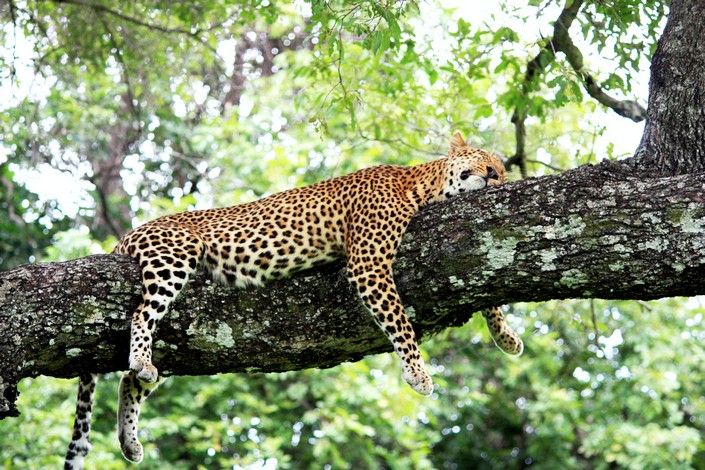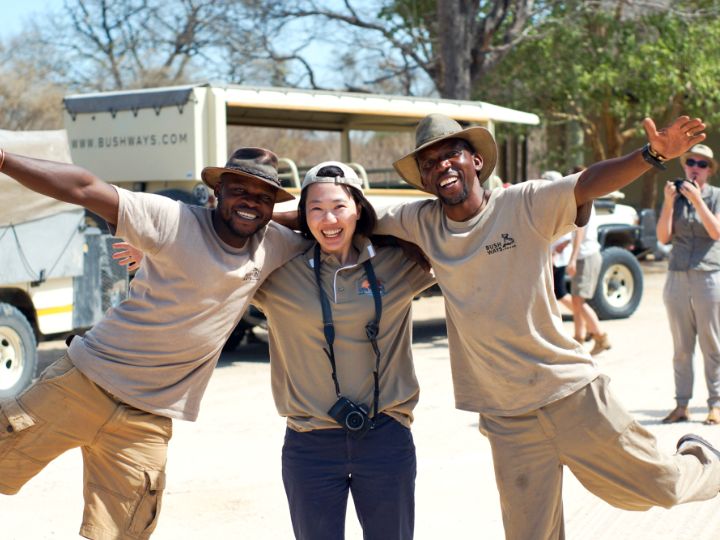One of the most spectacular wildlife events on the planet and the greatest movement of land mammals on Earth, is the Great Wildeebest Migration in East Africa. The spectacle involves the movement of more than 1.5 million wildebeest and 300 000 zebra and gazelle across the plains of the Masai Marai National Park in Kenya and the Serengeti National Park in Tanzania. As the antelope migrate, so do the predators, picking off their prey in the kind of dramatic scenes that nature documentaries are made of.
For most safari travellers and wildlife lovers, seeing the Great Migration is at the top of their bucket lists. However, there’s a lot that goes into planning a trip to see the Great Migration. Plans from working out where to go, to finding out how best to watch a spectacle that’s constantly on the move.
We’ve put together this comprehensive guide to help you plan your Great Wildebeest Migration safari to Kenya and Tanzania. So it’s your turn to experience Africa’s greatest wildlife show.
What is the Great Wildebeest Migration?
The Great Wildebeest Migration, also referred to as the Great Migration of the Wildebeest Migration, is an annual pilgrimage of nearly 2 million wildebeest, zebra and gazelle as they move from the Serengeti National Park in Tanzania to the Masai Mara National Park in Kenya in search of better grazing. After the seasonal rains bring fresh grass – quite literally following the saying “the grass is greener on the other side!”. Amazingly the antelope move along with a variety of predators; lions, leopard, cheetah and hyena who follow, waiting for the perfect moments to attack weak animals. Along with the migration, the wildebeest, zebra and gazelle mate, give birth and die. It’s estimated that around 250 000 wildebeest alone perish on the journey every year.
While many people think of it as an annual event, the Great Migration is in fact a continuous cycle. The animals move back and forth between the Masai Mara and the Serengeti in a circular route that spans around 3000 kilometres. During this time they cross the crocodile-infested Mara River, the natural boundary between the two national parks, each time as they move between the two countries.
When is the best time of year to see the Great Wildebeest Migration?
Deciding when to book your safari to see the Great Wildebeest Migration is probably the biggest factor when planning your trip. You certainly don’t want to go on safari to Kenya or Tanzania expecting to see vast herds of animals and arrive to find empty plains.
As the migration is a constant circular route, there’s no real annual start or end date. Rather, each year the animals move at different times because their pilgrimage is determined by rainfall, which is becoming increasingly unpredictable.
Here’s a month by month breakdown of the movement of the migration herds through Tanzania and Kenya. Please note that this is only a guide as the migration is a natural phenomenon governed by rains, and each year the exact timings of the herds’ movements can vary.
- January and February: At the beginning of the year, from early January to late February, nearly 400 000 wildebeest babies are born during the calving season which takes place in the Serengeti National Park and the Ngorongoro Crater Conservation Area in Tanzania. The herds are concentrated in the Ndutu and Salei plains (southern Serengeti and Ngorongoro Conservation area), attracting predators who prey on the vulnerable babies taking their first wobbly steps.
- March, April, May: From March through to mid-May the herds are in the southwestern Serengeti and the Maswa Reserve in Tanzania, taking full advantage of the lush vegetation as the young calves gain strength and grow stronger.
- May, June, July: The herds start moving further north into the Mbalageti/Grumeti region of the Serengeti (also known as the western corridor) starting in late May. This is one of the best times to experience the wildebeest migration in a beautiful region of the Serengeti. By July, the herds have amassed along the Grumeti River in the Serengeti, preparing to head northwards to the Masai Mara in Kenya.
- August and September: In August and September, the herds reach the Mara River and start to make the famous crossing into the Masai Mara in Kenya, many dying in the process, and many being eaten by crocodiles. These are the quintessential migration scenes you may have seen in nature documentaries – hordes of animals moving at once with single-minded purpose, and the dramatic deaths that happen along the way.
- October: The majority of the herds (the animals that survived the perilous Mara River crossing) are in the Masai Mara in October.
- November: In November, the herds start moving from the Masai Mara in Kenya southwards back to the Serengeti in Tanzania.
- December: The animals are now concentrated in the north-eastern and southern Serengeti, and at the end of the month the calving season begins again with the births of the first babies.
So when should you plan to see the Great Wildebeest Migration?
Choosing when to see the Great Migration depends on what you want to see. If you want to see wildebeest babies being born then travel to the Serengeti in January and February. Alternatively, if you want to see the animals on the move in one of the most beautiful areas of the Serengeti, then travel in May and June, while the end of August to the end of September is best time to see the animals doing the famous river crossing – the most dramatic scenes of the migration. If you want to see the animals in the Masai Mara, then September and October are the best months.
Overall, July to September is the most popular time of year to see the Great Migration, and while these months offer some of the most exciting sightings, you’ll also pay the highest prices for trips and accommodation, and most of your sightings will be accompanied by many other safari vehicles.
How do you see the Great Wildebeest Migration?
Travelling on an overland safari is the best way of seeing the Great Wildebeest Migration in Kenya and Tanzania. You can do your own self-drive safaris in the Serengeti and the Masai Mara but it’s much easier to go on an organised overland tour where you have an experienced guide and driver to navigate the bumpy roads of the parks and get you to the best spots to see the animals.
Lots of the overland trips to see the Great Migration focus on the Mara River crossings between the Masai Mara and the Serengeti, because these offer the most dramatic sightings of the migration, and many of them also include other parks in Tanzania and Kenya on the tour.
How do you choose between the Serengeti and the Masai Mara?
The herds spend most of the year on the vast plains of the Serengeti, Tanzania’s most famous national park. If you want to see the births of hundreds of thousands of wildebeest calves, then you need to be in the Serengeti in January and February. This is also the time of year when the herds are partly in the Ngorongoro Crater, a breathtakingly beautiful wilderness area in the crater of an extinct volcano. If you plan to travel to the Serengeti to see the Great Migration, then you also have the option of doing part of your safari in the Ngorongoro Crater to see a unique landscape abundant with wildlife.
The herds of animals are in Kenya’s Masai Mara from August to October, so if you want to visit this Kenyan reserve then these are the months to go. Some advantages of seeing the Great Migration in the Masai Mara are that the reserve is far smaller than the Serengeti, which means that the animal numbers are more concentrated than in the Serengeti. On the other hand, the small size of the Masai Mara means that sightings there can be incredibly crowded with safari vehicles jostling for a good view.
The ideal way to see the Great Migration is to visit both the Serengeti and the Masai Mara on one overland trip – they are, after all, right next to one another, separated by the natural boundary line of the Mara River.
How to see the Great Wildebeest Migration on a budget
Both the Masai Mara and the Serengeti are expensive safari destinations, and prices are highest during the busiest months of the migration. Having said that, it is possible to see the Great Migration on a budget by staying in campsites in the National Parks.
While you can do a self-drive safari in Kenya and Tanzania, most travellers find this too daunting, and instead stay at lodges or opt for an organised overland tour. Most lodges in the two National Parks are very pricey, so an overland safari is your best budget option. Going on an overland safari also gives you the chance to see several different parks in both Tanzania and Kenya, so that you have the full East African safari experience in addition to experiencing the Great Migration.
Great Migration Tour suggestions:
We offer a number of budget overland safaris to see the Great Wildebeest Migration in the Serengeti and the Masai Mara. On our overland trips you camp in the National Parks and spend your days on game drives, seeing those nature documentary scenes first hand.
Browse our Kenya and Tanzania safaris, which include this 10 day Kenya and Tanzania safari, where you see the best of the wildebeest migration in the Masai Mara and the Serengeti, as well as visit other amazing parks and reserves in Kenya and Tanzania.
If you want some beach down time on your East Africa holiday after seeing the Great Migration in the Masai Mara and the Serengeti, go for our 15 day Kenya and Tanzania safari, which ends off on the icing sugar sand beaches of the beautiful island of Zanzibar.
One of our most budget-friendly trips is the 4 day Serengeti budget mobile safari, where you’ll see the Great Migration in the Serengeti and stay in a mobile camp each night and spend your days on game drives through the park tracking the migrating herds.
If you’re not one for camping, then our 10 Day Best of Kenya and Tanzania tented camps is the trip for you. Instead of staying at campsites, you’ll stay in safari lodges and tented camps (where you sleep in permanent luxury tents set on wooden platforms) which give you a taste of wild camping without skimping on comfort.





0 Comments